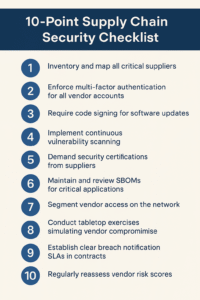Supply Chain Attacks

Supply chain attacks have become one of the most dangerous cybersecurity threats of the past decade. Unlike traditional breaches, attackers no longer need to break down the front door. Instead, they compromise a trusted supplier, service provider, or software vendor and ride that trust directly into the heart of their targets. From SolarWinds to NotPetya to CCleaner, the message is clear: an organization is only as secure as the weakest link in its supply chain. This article explains what supply chain attacks are, how they work, why they’re so devastating, and—most importantly—what you can do to defend against them.
What is a Supply Chain Attack?
A supply chain attack is a cyber intrusion that exploits third-party products, services, or processes to infiltrate organizations downstream. Attackers compromise an upstream provider, allowing malicious code, backdoors, or unauthorized access to propagate into customer environments.
Three Main Categories
- Software Supply Chain Attacks – Malicious code is inserted into updates, open-source libraries, or development pipelines.
- Hardware Supply Chain Attacks – Components such as routers, servers, or IoT devices are tampered with before delivery.
- Service/Vendor Compromise – Managed service providers (MSPs), SaaS vendors, and contractors are exploited as stepping stones into customer networks.
Why Supply Chain Attacks Are So Dangerous
- Trusted Relationships – Vendors are often whitelisted, signed, or given privileged access.
- Amplification Effect – One compromise can cascade into hundreds or thousands of victims.
- Detection Challenges – Malicious activity is often embedded in legitimate updates or trusted traffic.
- Global Impact – Attacks cross borders, affecting governments, critical infrastructure, and private companies alike.

Real-World Case Studies
NotPetya (2017)
Distributed via a Ukrainian accounting software (M.E.Doc), NotPetya spread globally, disrupting Maersk, FedEx, and pharmaceutical companies. Though disguised as ransomware, it was effectively a destructive wiper.
CCleaner (2017)
Attackers compromised Piriform’s CCleaner, pushing malware through legitimate updates to millions of users. This remains one of the clearest examples of a software supply chain compromise targeting consumers and enterprises alike.
SolarWinds (2020)
Hackers inserted malicious code into Orion platform updates. Once installed by government agencies and Fortune 500 companies, it gave attackers remote access to sensitive systems.
Kaseya VSA (2021)
Exploiting zero-day flaws in Kaseya’s remote management tool, attackers delivered ransomware to managed service providers and their downstream clients, magnifying the scale of damage.
Log4Shell (2021)
A vulnerability in the ubiquitous Log4j open-source library allowed attackers to execute code remotely in countless applications. Unlike targeted compromises, this demonstrated how dependency flaws can explode into a global crisis overnight.
Common Attack Vectors
- Compromised Software Updates – Injecting malware into update packages.
- Malicious Open-Source Dependencies – Uploading or modifying packages with hidden backdoors.
- Third-Party Service Providers – Exploiting MSPs, SaaS platforms, or contractors.
- Hardware Tampering – Modifying chips, firmware, or physical devices.
- Insider Threats – Disgruntled or coerced employees in the supply chain introducing backdoors.
Impact on Industries
- Government – Espionage and disruption of national security systems.
- Healthcare – Targeting patient data, hospital operations, and medical devices.
- Critical Infrastructure – Energy, transport, and utilities disrupted via upstream vendors.
- Technology & IT – Development pipelines and SaaS providers exploited to spread malware.
Defensive Strategies
1. Vendor Risk Management
- Conduct thorough due diligence before onboarding vendors.
- Require certifications (ISO 27001, SOC 2, FedRAMP).
- Establish breach notification and security obligations in contracts.
2. Zero Trust Security
- Never assume suppliers are safe by default.
- Apply least-privilege access for all vendor accounts.
- Continuously verify identities, devices, and workloads.
3. Supply Chain Mapping & SBOMs
- Maintain an up-to-date map of all software, libraries, and dependencies.
- Use Software Bill of Materials (SBOMs) to track components.
- Automate monitoring with tools like Anchore, Syft, or Dependency-Track.
4. Threat Detection & Monitoring
- Deploy anomaly detection and behavioral monitoring for vendor traffic.
- Implement Endpoint Detection and Response (EDR).
- Monitor for Indicators of Compromise (IOCs) tied to supply chain exploits.
5. Incident Response & Resilience
- Develop playbooks for vendor compromise scenarios.
- Run tabletop exercises with key suppliers.
- Keep robust backups and disaster recovery plans.
Emerging Trends
- AI-Powered Attacks – Adversaries are using AI to automate reconnaissance, insert code poisoning into open-source repositories, and evade detection.
- Deepfake Vendor Impersonation – AI-generated voices and video trick procurement teams into approving malicious updates or contracts.
- Tighter Regulations – Governments are mandating SBOMs, disclosure requirements, and supply chain security standards (e.g., NIST SP 800-161, ISO/IEC 27036).
10-Point Supply Chain Security Checklist
- Inventory and map all critical suppliers.
- Enforce multi-factor authentication for all vendor accounts.
- Require code signing for software updates.
- Implement continuous vulnerability scanning.
- Demand security certifications from suppliers.
- Maintain and review SBOMs for critical applications.
- Segment vendor access on the network.
- Conduct tabletop exercises simulating vendor compromise.
- Establish clear breach notification SLAs in contracts.
- Regularly reassess vendor risk scores.
Conclusion
Supply chain attacks are not just another cyber threat—they represent a fundamental vulnerability in modern interconnected business. Attackers know that compromising one vendor can unlock access to thousands of victims. The only effective defense is a multi-layered approach: strong vendor risk management, zero trust principles, continuous monitoring, and resilience planning. By adopting these practices, organizations can reduce their exposure, improve resilience, and prevent the next SolarWinds from becoming their headline. Cybersecurity no longer stops at your firewall—it extends to every supplier, every line of code, and every device that enters your network.


